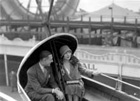
Hindle Wakes 1927
Distributed by Milestone Films & Video, PO Box 128, Harrington Park, NJ 07640-0128; 800-603-1104
Produced by Maurice Elvey and Victor Saville
Directed by Maurice Elvey
DVD, b&, 117 min.
Jr. High - Adult
Film Studies
Date Entered: 06/07/2005
Reviewed by Oksana Dykyj, Head, Visual Media Resources, Concordia University, MontrealThis second of four film adaptations of Stanley Houghton’s 1912 play is groundbreaking on a number of levels: The play itself initially caused quite a stir in that it dealt with a modern attitude toward the sexual double standard. The film molds this narrative into one that additionally addresses issues of class and infuses it with spectacular location cinematography. Hindle Wakes is undoubtedly one of the most important films from the British silent period.
The fictional town of Hindle is a typical mill town in Lancashire. The town’s workforce is employed in the mills. Many of them live on Cotton Street while the factory owner lives on Midas Street. The class distinctions are also continuously shown as comparisons in footwear. The working class wears inexpensive shoes and cotton hose while the rich own numerous pairs of shoes. However, the characterization of the women at the factory is decidedly modern in how they look and approach life. They are lively, happy and on equal footing with the men with whom they work. Fanny (Estelle Brody) wears her hair in a shaggier version of the Louise Brooks bob and her friend Mary (Peggy Carlisle) sports a closely sheared boyish cut. The mills shut down for a week’s holiday (the wakes) and the young women, along with many other factory workers, go off to Blackpool, a seaside resort. There they meet men and Fanny, in the heat of a romantic moment goes off with Allen (John Stuart), the son of the owner of the mill where she works, for the rest of the week. The exuberance of the vacation is shown through the exhilarating camera movements placed on roller coasters, or taking in a vast dance hall. The film overcomes the difficulties of lighting when shooting on location. In the case of the Palace dance hall, the camera was located in the balcony area looking down on the masses of people dancing and turning in a methodical counter-clockwise direction. The movement comes from the dancing but also from the brushstrokes of light from the spotlights illuminating them. The camera holds on the hundreds of dancers for an appropriately long time, enough to get a sense of immediacy about the people who went to Blackpool for their week’s vacation. The documentary aspect of this film reveals life as it was in England in the late 1920s. At the Palace, we see numerous women dancing together, a common practice at the time. We encounter what was fashionable in terms of amusement park rides or attractions such as beautifully lit buildings at night, showcased remarkably well considering the speed of film stocks at this point.
The narrative then veers into atypical territory in that Fanny regards her sexual fling, much as a man might, as a bit of fun but not a prelude to a marriage commitment. When her family finds out how she actually spent her vacation, her father confers with Allen’s father and a decision is made that Allen will have to marry her and make a good woman out of her. Fanny defiantly refuses to marry Allen and is forced to move out of the family home due to the shame she brought on them. Yet, life goes on in Hindle. The vacation is over and Fanny goes back to her job at the mill, her social life with her peers unscathed. Not only does she defy Edwardian morality by acting on her sexual impulses, she manages not to let herself be trapped by the ramifications of her actions. The fact that at the end of the film, she is asked out to the movies by one of her co-workers rather than shunned, also indicates a considerable shift in young men’s attitudes at this time.
The DVD print is taken from the BFI restoration and looks sharp and balanced. It comes with a choice of two soundtracks: the first, a modern synthesizer score by In The Nursery, works well in setting the mood and does not overwhelm the film. The second, by composer and silent film accompanist Phil Carli, provides a correct contemporary sound to the period the film was released. Other features include stills, the original press-kit, and an article that Emma Goldman wrote about the play in 1914. This film is a must acquisition for libraries collecting in areas of women’s tudies and film studies. It is also recommended for other academic areas dealing with the history of popular culture and the history of theatre. Highly recommended.